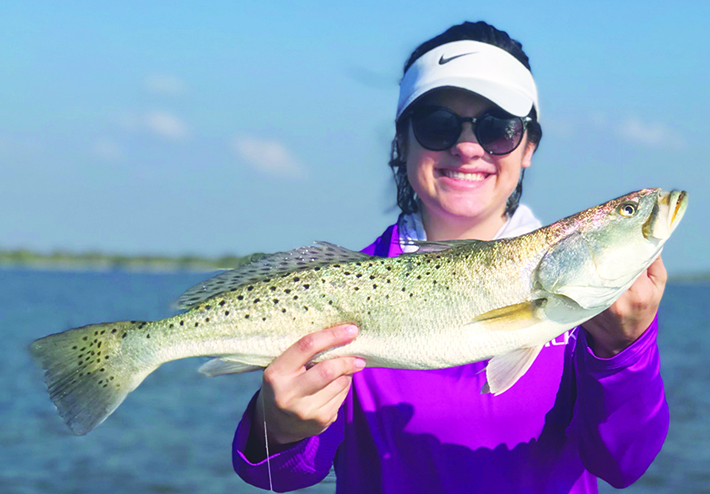Tags for trout, other fish, may be required in future
Published 12:46 pm Tuesday, May 7, 2024
|
Getting your Trinity Audio player ready...
|
These two things do not sound like they go together:
“An act to provide further regulatory relief for the citizens of North Carolina”;
Trout tags.
But they might be.
The former is a statement at the beginning of House Bill 600, passed by the N.C. General Assembly last fall.
The latter may be the result of the former.
The NCGA, trying to “provide further regulatory relief” to us commoners, has decided that, beginning Dec. 1, all recreational fishermen catching five species of saltwater fish in North Carolina waters – red drum, spotted seatrout, weakfish (aka gray trout), flounder and striped bass – must report those catches to the N.C. Division of Marine Fisheries – the agency that has made several rules over the past decade that have made it more difficult to catch some of those very species.
The NCGA has given the NCDMF and the N.C. Wildlife Resources Commission a $5 million, one-time payment, to come up with a system for reporting those catches.
Yes, tags for trout are possible, but at least not likely. How we will report the trout and reds and flounder we catch will be; however, the cmmission – the more-reliable agency when it comes to figuring out how to quantify and protect the state’s resources – comes up with.
For a change, and apparently quite by accident, the new law will also affect commercial fishermen. Beginning Dec. 1, commercial fishermen are required to report every fish they catch, whether they sell them or not. So those fish they catch and donate to local churches, volunteer fire departments, etc., for fund-raising fish fries – they have to be reported, and they will count toward commercial catch allocations. Think that won’t go over like a lead balloon?
Beginning on Dec. 1, any fisherman found to have caught a red, speck, flounder, gray trout or striped bass and not reported it, will receive a verbal warning. On Dec. 1, 2025, that verbal warning turns into a warning ticket. On Dec. 1, 2026, it turns into a ticket and $35 fine, plus, it gives the director of NCDMF or NCWRC the power to suspend the license privileges of the guilty party.
That’s some kind of “regulatory relief,” isn’t it?
Why is it necessary? Is it a shot at attempting to get a more accurate look at the number of fish that recreational fishermen are catching? Especially when statistics NCDMF has been using as a baseline for regulatory changes – think one-fish daily limit on flounder, for only two weeks a year – have been discovered to be, well, a joke.
An immediate thought. What’s going to happen on Saturday and Sunday nights for eight or nine months a year, when all those weekend warriors put up their saltwater fishing tackle and try to access whatever computer system or free telephone-reporting system is in place, to let the authorities know about the two speckled trout and one red drum they caught that day? Can you say “system meltdown?”
Can’t these guys get anything right? If you don’t think so, you can send an opinion to two addresses or one email address:
N.C. Marine Fisheries Commission, Rules Comments, P.O. Box 769, Morehead City, N.C. 28557;
Rulemaking coordinator, N.C. Wildlife Resources Commission, 1701 Mail Service Center, Raleigh, N.C. 27699-1700.
regulations@ncwildlife.org.
State sets migratory
bird hunting seasons
The N.C. Wildlife Resources Commission has set migratory bird hunting seasons and bag limits for the 2024-25 season.
• Doves: Sept. 2-Oct. 5, Nov. 9-30, Dec. 16-Jan. 31. Fifteen per day;
• Woodcock: Dec. 11-Jan. 31. Three per day;
• Canada goose: Sept. 2-30 (statewide). Fifteen per day. Oct. 17-26, Nov. 9-30, Dec. 18-Feb. 8. Five per day, except in NE Hunt Zone, 1 per day;
• Teal: Sept. 12-30 east of US 17. Six per day;
• Ducks: Oct. 17-19 (Inland Zone), Oct. 25-26 (Coastal Zone); Nov. 9-30, Dec. 19-Jan. 31 (statewide). Six per day with certain species limits: no black ducks or mottled ducks before Nov. 23, 4 mallards (no more than 2 hens), 3 wood ducks, 2 redheads, 2 black ducks, 2 canvasbacks, 1 pintail, one mottled duck, 1 fulvous whistling duck, 5 mergansers (2 hooded).
• Sea ducks: Oct. 25-26, Nov. 9-30, Dec. 18-Jan. 31. Four per day, no more than 3 scoters, 3 eiders (one hen), 3 long-tailed ducks;
• King and clapper rails: Sept 2-Nov. 21. Fifteen per day;
• Sora and Virginia rails: Sept. 2-Nov. 21. Twenty five per day;
• Gallinules and Moorhens: Sept. 2-Nov. 21. Fifteen per day;
• Snipe: Oct. 28-Feb. 28. Eight per day.
• Light geese (snow and Ross’s): Oct. 8-Feb. 8, Feb. 10-March 31 (by permit only). Twenty five per day.
• Brant: Dec. 28-Jan. 31. One per day.
• Tundra swan: Nov. 9-Jan 31 (by permit only). One per season.
Youth waterfowl days will be Feb. 1 and 8, for ages 17 or younger.
NC pros earn cash
in Bassmaster tourney
Three North Carolina bass pros pocketed some nice checks in the Bassmaster Elite tournament on Florida’s St. John’s River April 18-21.
Matt Arey of Shelby finished ninth and won $16,000 for a four-day total of 20 fish weighing 64 pounds, 13 ounces.
Jake Whittaker of Hendersonville finished 33rd with 14 fish weighing 40-13, earning $11,000; and Brandon Card of Salisbury was 34th with 15 fish weighing 40-11, winning $10,000.



